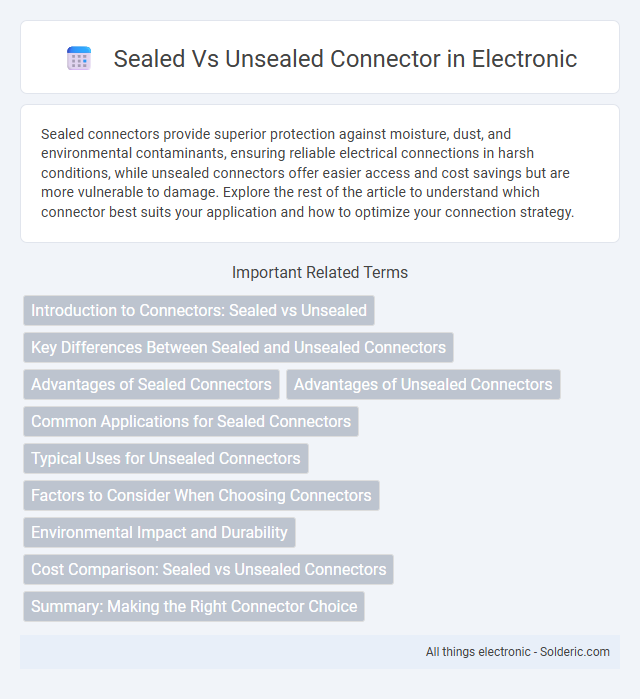Sealed connectors provide superior protection against moisture, dust, and environmental contaminants, ensuring reliable electrical connections in harsh conditions, while unsealed connectors offer easier access and cost savings but are more vulnerable to damage. Explore the rest of the article to understand which connector best suits your application and how to optimize your connection strategy.
Comparison Table
| Feature | Sealed Connector | Unsealed Connector |
|---|---|---|
| Protection | Waterproof and dustproof | No protection against moisture or dust |
| Application | Outdoor, harsh environments, automotive | Indoor, clean environments |
| Durability | High resistance to corrosion and contaminants | Lower resistance, prone to damage |
| Cost | Higher cost due to sealing materials | Lower cost, simpler design |
| Installation | Requires careful sealing and alignment | Easy and quick to connect |
| Maintenance | Less frequent, due to protection | More frequent cleaning and checks needed |
Introduction to Connectors: Sealed vs Unsealed
Sealed connectors provide a robust barrier against moisture, dust, and environmental contaminants, making them ideal for harsh operating conditions and outdoor applications. Unsealed connectors lack this protective sealing, typically offering easier installation and maintenance but are more vulnerable to damage in challenging environments. Choosing the right connector depends on your specific application requirements, including exposure levels and durability needs.
Key Differences Between Sealed and Unsealed Connectors
Sealed connectors provide enhanced protection against moisture, dust, and contaminants through integrated gaskets or seals, ensuring reliable performance in harsh environments. Unsealed connectors lack these protective barriers, making them more susceptible to environmental factors but often easier to install and cost-effective for less demanding applications. Your choice between sealed and unsealed connectors depends on the required durability, environmental exposure, and application-specific needs.
Advantages of Sealed Connectors
Sealed connectors offer superior protection against moisture, dust, and environmental contaminants, ensuring reliable electrical connections in harsh conditions. Their robust design enhances durability and reduces the risk of corrosion, extending the lifespan of your wiring systems. This reliability makes sealed connectors essential for automotive, industrial, and outdoor applications where exposure to elements is common.
Advantages of Unsealed Connectors
Unsealed connectors offer superior ventilation and heat dissipation, reducing the risk of overheating in electronic systems. They are easier to inspect and maintain due to their exposure, enabling quicker troubleshooting and repair. Cost-effective manufacturing and installation make unsealed connectors ideal for applications where environmental sealing is unnecessary.
Common Applications for Sealed Connectors
Sealed connectors are commonly used in automotive, aerospace, and industrial machinery applications where protection against moisture, dust, and harsh environmental conditions is critical. These connectors ensure reliable electrical performance in engine compartments, outdoor lighting systems, and heavy equipment. Their robust design prevents corrosion and electrical failures, making them essential for safety-critical and high-performance systems.
Typical Uses for Unsealed Connectors
Unsealed connectors are typically used in indoor electronic devices where environmental protection is not a priority, such as consumer electronics, computer peripherals, and office equipment. These connectors provide easy access for frequent mating and unmating, making them ideal for applications that require quick assembly or maintenance. Their cost-effectiveness and simplicity make them suitable for low-risk environments without exposure to moisture, dust, or contaminants.
Factors to Consider When Choosing Connectors
Key factors to consider when choosing sealed versus unsealed connectors include environmental exposure, moisture resistance, and application requirements. Sealed connectors provide robust protection against dust, water ingress, and contaminants, making them ideal for harsh outdoor or industrial environments. Unsealed connectors are suitable for dry, controlled conditions where ease of access and cost-efficiency are prioritized.
Environmental Impact and Durability
Sealed connectors offer superior protection against moisture, dust, and corrosive elements, significantly reducing environmental impact by preventing component damage and extending product lifespan. Unsealed connectors are more vulnerable to contamination and wear, leading to frequent replacements that increase electronic waste and environmental strain. Choosing sealed connectors ensures your systems maintain durability and reliability in harsh conditions, minimizing maintenance costs and ecological footprint.
Cost Comparison: Sealed vs Unsealed Connectors
Sealed connectors generally have higher upfront costs than unsealed connectors due to their specialized materials and design features that provide environmental protection. Unsealed connectors offer a cost-effective solution for applications where exposure to moisture, dust, or contaminants is minimal. Choosing between these connectors depends on your budget and the level of protection required for reliable performance in harsh conditions.
Summary: Making the Right Connector Choice
Choosing between sealed and unsealed connectors depends on environmental exposure and application requirements. Sealed connectors offer superior protection against moisture, dust, and contaminants, making them ideal for harsh conditions such as automotive and industrial use. Unsealed connectors provide cost-effective connectivity for controlled environments where sealing is unnecessary, ensuring efficient performance without added complexity.
Sealed vs Unsealed connector Infographic

 solderic.com
solderic.com